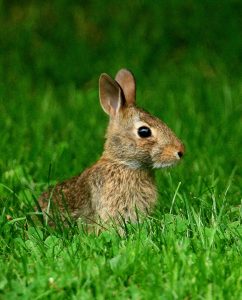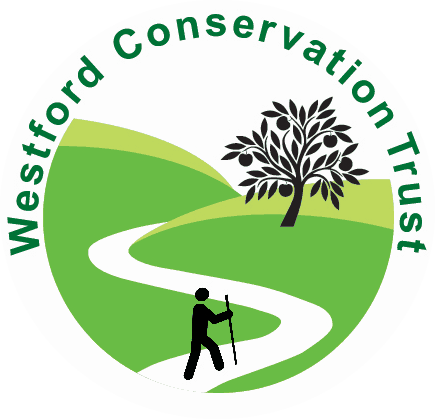Chemical Free Lawns

Our lawns should be kept chemical free, and mown less frequently. Rob Moir of the Ocean River Institute of Cambridge, MA has studied lawns and bees. He found in a study he conducted in Springfield MA this past May that “lawns mowed every three weeks instead of weekly resulted in as many as 2.5 times more lawn flowers, mostly clover and dandelions, and a great diversity of 93 species of bees [“Hope for the Bees”, posted on May 20, 2021 on the Ocean Rivers Institute online website] Moir states, “Established lawns should not need fertilizing. They, like the grasslands of old, are quite capable of taking care of themselves.” He further found that fertilizing lawns or using herbicides or pesticides weakens them. He states. “Toxins must follow applied nutrients because [fertilized] grass is developing an addiction, is thinner with less fiber, and is easy forage for pests.”
According to Moir, natural grass lawns, with plenty of clover and other flowering plants in them build soil by exuding carbohydrates from roots. This can build as much as an inch of soil per year. And a healthy lawn sequesters carbon in the ground. Moir states, “For one ton of soil, grass plants pull more than four tons of carbon dioxide out of the atmosphere”. Leaving lawns be benefits our pollinators and our atmosphere. Using chemicals such as Round-Up on lawns, kills most of the beneficial micorrhizae fungi that connect trees and other plants. The healthier the lawn, the more worms and insects can open it up and aerate it. The lawn will then hold up to seven times more moisture. This is especially important in times of drought.
The Rose Kennedy greenway in Boston is entirely chemical free, and yet looks healthy and green. It contains several species of grass and other low plants that are bee pollinated. The same is true of Westford’s town common, so that children can play freely on the grass. The Town of Westford’s Policy on Pesticide Use states,
“…the Town of Westford recognizes that it is in the best interest of public health to manage Town properties through an Integrated Pest Management (IPM) plan that is an ecologically-sound approach to suppressing and eliminating pest populations to keep them from causing health, economic, or aesthetic injury; and to encourage private property owners to manage their property through the use of Organic Pest Management (OPM), a natural, organic approach to turf grass and landscape management without the use of toxic pesticides.”
Moir concludes his article with this Ocean Rivers policy statement: “We are calling for a full stop to spreading quick-release fertilizer on established lawns, full stop to nutrient pollution run-off that feeds harmful algal blooms, and full stop to the bioaccumulation up the food chain of toxins….Tread lightly and treat lawns naturally.”
Many thanks to all flora and fauna reporters for the month of June. Please send reports by July 26 for inclusion in next month’s article. You can call me at 692-3907, write to me at 7A Old Colony Drive, or e-mail me at mariancharman@gmail.com.
————————–
Late May Reports:
Marian Harman, Old Colony Drive. May 25, a walk to Snake Meadow Brook. Lots of young trees, both deciduous and pine, and lots of ferns and blueberries coming up in the large blow-down area. Blooming: blueberries, Canada Mayflower, starflower, polygala, bull lilies, wild geranium, bluets. Painted turtles basking on every sunny bank, root or rock in the brook–counted 40-50 of them. Green frogs sounding like banjo strings being plucked. Singing: song sparrow, rose-breasted grosbeak, oriole, cardinal, red-bellied woodpecker, white-breasted nuthatch, downy woodpecker, grackles and red-winged blackbirds on territory in the brook, two ravens passing overhead. May 30, 40 degrees, rainy, windy. Heard on Pilgrim Drive: fish crows, scarlet tanager, wood pee-wee, great-crested flycatcher.
Roy Perry, at Frances Hill Wildlife Sanctuary May 28, “Just as I was about to call it a day a blue jay gave a single warning call and flew off…I looked around where the jay was and spotted the owl. I was lucky as the owl was facing me and there were no branches in line of sight.” [Roy sent a good photo-MH].
June Reports:
John Piekos, Dunstable Rd. June 3, “Caught on wildlife camera, Doe and fawn, ermine, groundhog, barred owl–busy week!”[great photos John-MH]
Leslie Thomas, Old Colony Drive. June 4, large turtle, at least 2 ft. across, was digging in the wood chips in the back yard, laying eggs in the hole she dug–I think a snapping turtle [Leslie sent good photos-MH]. June 24, lovely white-tailed doe in back yard. Also, a wren is nesting in the wreath on my door.
Gerry DiBello, Court Rd. June 12, “We have a hanging dish in our backyard we fill with mealworms that has attracted bluebirds. We were just watching a male and female bluebird feeding two babies perching on a branch above the feeder. The babies have speckled wings and a little blue on their tails. In another first we put up a bluebird house this year and either the family I just mentioned or, another is occupying it.”
Marian/Bill Harman, Old Colony Drive. June 13, 70’s, sunny, lovely. Ovenbird singing in the woods, robins nesting under our deck, great-crested flycatcher heard repeatedly, hermit thrush heard in swamp, wood thrush heard across the street. Red-winged blackbirds and cardinal pair at feeder. June 16, 70’s, lovely. A walk to Snake Meadow Brook: scarlet tanager, pair of rose-breasted grosbeaks, robin, tufted titmouse, chickadee, blue jays, mourning dove, cardinal, wood thrush, hermit thrush, veery (the trifecta of thrushes!), common yellowthroat, catbird, Carolina wren, song sparrow, chipping sparrow, red-bellied woodpecker, grackles, red-winged blackbirds. Parent robin is feeding two babies in the nest under the deck. June 17, a walk at East Boston Comps, in area of trolley line to Burge’s Pond and to Keyes Brook. So beautiful, like a cathedral, very tall trees, glacial erratic boulders. I was surprised to see that most of the trees in this area are oaks, not pine. Saw or heard, chipping sparrow, downy woodpecker, great-crested flycatcher, red-winged blackbird, kingbird, ovenbird, tufted titmouse, pileated woodpecker, Baltimore oriole, red-eyed vireo, song sparrow, blue jays, hairy woodpecker. Plants: lady’s slippers, Canada mayflower, partridgeberry, starflower, maple-leaved viburnum, sarsaparilla, twisted stalk, solomon’s seal, low-bush and high-bush blueberries, wintergreen, Yellow birch, hickory, a few hemlocks, white pine, lots of witch hazel.
June 22, baby blue jays chasing parents around and squeaking. They look just like their parents, but sound like babies. June 25, 60’s, damp. Three baby robins in nest under the deck are almost two big to fit in their nest. Papa robin is spending lots of time on our deck railing checking out intruders and guarding the nest. He chased a blue jay that landed on the railing and looked down at the nest. Under the feeder, ten gray squirrels (most ever), one red squirrel and two chipmunks. Fortunately they don’t seem to be able to get over our double-baffle system. June 26, the baby robins fledged today! They’re hopping around on the lawn, looking clueless.
Tom Lumenello, Old Colony Drive. June 15, “The wrens have returned, its feeding time with a nymph fly being served for lunch” [Tom sent a lovely photo of a house wren feeding young at his bird house-MH]
Bob Price, Stratton Hill Rd. June 23, the bluebirds have fledged their first brood. I think they are building a second nest now.
Sue Thomas, Old Homestead Rd. June 25, “We saw what I believe was a King Rail on our walk today by the pond at the bottom of Old Homestead and Long Meadow. I had never seen one before and had to look it up, but the beak and coloring are pretty distinctive….It might be a Virginia rail, but it was right at my feet and flashed its tail at me and the coloration looked much more like a King Rail. I would never have seen it if it hadn’t startled.” [King Rail is very rare in Massachusetts and is an exciting report! MH]
Rosemarie Koester, Providence Rd. June Report: Blue jays, many grackles, two pairs of cardinals, lots of goldfinches, house finches and maybe purple finches, chickadees, tufted titmouse, woodpecker: red-bellied, downy woodpecker pair. Robins nest in the rhododendron bush. I checked daily but Mr. robin was fiercely protective and fussed loudly when I was near the nest. I finally stayed away. After two days of heavy rain, the nest was disturbed with a hole at the bottom and no birds.” Pair of rose-breasted grosbeaks. The female chased other birds away from the feeder. The male is a bit shy and easily chased when the grackles come. Hawk flying overhead, loner wild turkey daily, sometimes see 3-6. Snake in back yard near the marsh. Mammals: deer in woods behind house, bobcat in back yard, several rabbits who are eating my hosta and black-eyed susans, gray squirrels chasing each other, many chipmunks. On Bridge St., saw a red fox.
Marian Harman is a member of the Westford Conservation Trust, a non-profit conservation organization, whose purpose is the preservation of Westford’s open spaces and trails. The Trust welcomes new members and volunteers. Check out our website at westfordconservationtrust.org or visit us on Facebook.
